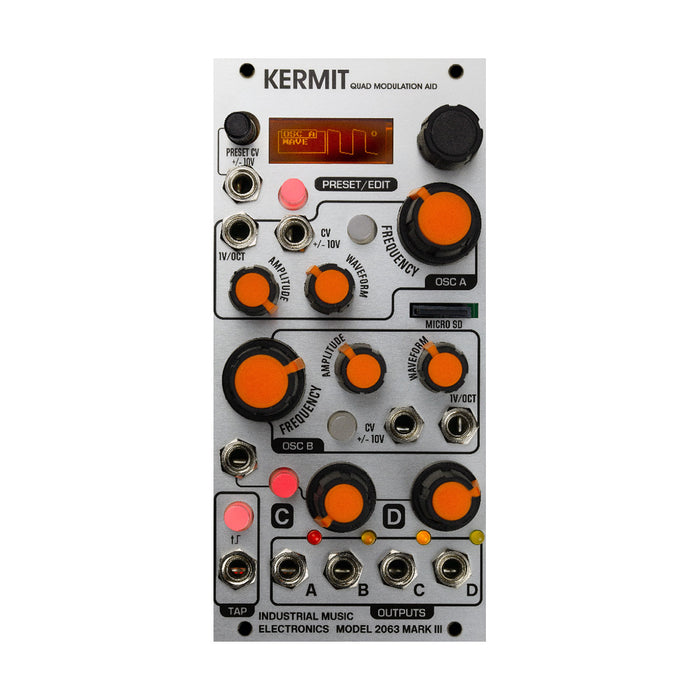
Industrial Music Electronics Kermit mkIII
Format: Eurorack
Width: 12HP
Depth: mm
Current: 135mA @ + 12V, 50mA @ -12V
Manual pdf (English)

Format: Eurorack
Width: 12HP
Depth: mm
Current: 135mA @ + 12V, 50mA @ -12V
Manual pdf (English)
Kermit is a 4-channel, tempo-synchronized, wavetable oscillator (optimized for LFO) that allows you to switch between many modes. The C and D oscillators have only one knob, but parameters that are almost the same as A and B can be set independently by operating the button combo.Each channel acts as an LFO, oscillator, envelope, random, sample and hold. The Frequency, Waveform, and Amplitude parameters have different functions depending on the operation type, but they have roughly similar functions.Each parameter can be assigned to the modulation destination of the external CV input.Also, as a feature of Kermit, each other without patchingModulation between channelsis. Packing the maximum possible patch in a compact body.
The signal is output as a 16-bit signal by default, so even a slow LFO can draw an accurate waveform. The pitch stability as an oscillator is deliberately modest, with lower frequencies providing more stability. The sound quality has a crunchy texture unique to digital. Can be accessed from the channel menuCharacterDepending on the setting, the waveform can be made more lo-fi. Each lo-fi waveform is also given a unique character, and when it comes to lo-fi, it becomes 8 samples in 32 bits, which is close to the texture of a vintage Konami SCC chip. From micro SD cardOriginal waveformIt is also possible to load. Like the Piston Honda Mk3, the loaded wavetable is a free wavetable developed by Synthesis Technology.WaveditIt can be created by software. Place the wavetable file with the name "1.wav" in the top folder of the micro SD card formatted with FAT and load it from "Load Waves from SD" in the global menu. The original wavetable will be erased, but the IMEWebsiteIt can be downloaded from.
Each operation type can operate in synchronization with a clock that is a divided master tempo. Master tempo isTAPSet from the section using the Tap tempo button or the clock input.
Parameter settings other than all assignments and knobspresetStored in the CV to switch between multiple presetsMorphingIt is possible to. Preset morphing is possible with all IME Mk3 series modules, but Kermit will be particularly powerful.
In CH C / D, one knob for each channel sets the same parameter as CH A / B, so turn the knob while pressing the button. The following table shows the buttons corresponding to each parameter. For example, to set the CH D Wave, hold down the CH B button and the CH C / D common button and turn the CH D knob.

Set the CV input assign destination for each channel as shown in the following table. For example, if you want to modulate the Waveform with the Channel A CV input, hold down the encoder and turn the CH A Waveform knob. CH C / D has one CV input in common and has few knobs, so the assignment method is different. For example, if you want to modulate the size of CH D with the C / D common CV input, turn the CH D knob while holding down the encoder and CH A button.

The modulation assignments between each channel are set as shown in the table below. For example, if you want CH D to modulate CH B Frequency, turn the CH B Freq knob while holding down the C / D common button and encoder. If you want CH C to modulate the CH D Waveform, hold down the C / D common button, encoder, and TAP button, and turn the CH D knob. 
If you press one of the CH A, B, C / D buttons while holding down the encoder, the correspondingChannel menuAppears on the display. CH C / D has the same menu screen, and CH D is displayed after CH C. In addition to selecting the operation type and mode, you can select the voltage range (12Vpp: for LFO or random, 0-6V: for envelope, 1Vpp: for video synthesizer), clear assignments and the above Character selection.
If you press the button near the display while holding down the encoderGlobal preset menuIs displayed. You can save, recall, and clear presets as well as set CV control settings for presets and load wavetables from the above micro SD.